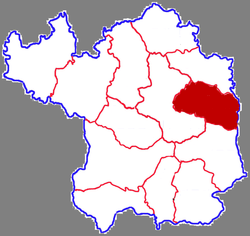Yanchang County
Yanchang County (simplified Chinese: 延长县; traditional Chinese: 延長縣; pinyin: Yáncháng Xiàn) is a county under the administration of the prefecture-level city of Yan'an, in the northeast of Shaanxi Province, bordering Shanxi Province across the Yellow River to the east. It has a land area of 2,368.7 square kilometers, and a population of 158,000.[1]
Yanchang 延长县 Yenchang | |
|---|---|
County | |
 Yanchang in Yan'an | |
.png) Yan'an in Shaanxi | |
| Coordinates (Yanchang County government): 36°34′45″N 110°00′44″E | |
| Country | People's Republic of China |
| Province | Shaanxi |
| Prefecture-level city | Yan'an |
| Area | |
| • Total | 2,368.7 km2 (914.6 sq mi) |
| Population (2018) | 158,000 |
| Time zone | UTC+8 (China Standard) |
| Postal code | 717100 |
Administrative divisions
Yanchang County consists of one subdistrict and seven towns.[1][2] These are then further divided into 159 administrative villages.[1]
Qilicun Subdistrict
Qilicun Subdistrict (七里村街道; Qīlǐcūn Jiēdào) is the county's sole subdistrict.[1][2] Qilicun Subdistrict host's the county's administrative offices.[2]
Towns of Yanchang County
Yanchang County contains the following seven towns:[1][2]
- Heijiabao Town (黑家堡镇; Hēijiābǎo Zhèn)
- Zhengzhuang Town (郑庄镇; Zhèngzhuāng Zhèn)
- Zhangjiatan Town (张家滩镇; Zhāngjiātān Zhèn)
- Jiaokou Town (交口镇; Jiāokǒu Zhèn)
- Luozishan Town (罗子山镇; Luōzishān Zhèn)
- Leichi Town (雷赤镇; Léichì Zhèn)
- Angou Town (安沟镇; Āngōu Zhèn)
Geography
Located on the Loess Plateau,[2] the county's terrain is largely hilly, with a low point of 470.6 meters high, and a high point of 1,383 meters high.[1] The Yellow River passes through the county, as does the Yan River.[1] The county has a forest coverage of 23%.[1]
Climate
Yanchang County experiences distinctive seasons in regards to both temperature and precipitation.[1] The county has warm and wet summers, and cold and dry winters.[1] The county has an average annual temperature of 10.4 °C, an average of 2504.6 hours of sunshine per year, and an average of 564 millimeters of precipitation per year.[1]
History
Human activity in Yanchang County can be traced back thousands of years, and the first administrative district in the area arose in 266 AD.[1]
Qingjian Uprising and Communist insurgency
Communist activity in the area began on January 1927, when a Communist Party branch was set up at a high school in the county.[1] On October 14, 1927, party leaders Tang Shu and Xie Zichang lead an uprising called the Qingjian Uprising, which had failed.[1] However, Communist Party activity in the region continued in subsequent years. In the spring of 1932, a communist uprising in the area occurred yet again, and the Communist Party organized militias afterwards.[1] On May 30, 1935, Communist troops successfully took control of the county.[1] Communist forces would retain control of the county during the rest of the Civil War, as well as during the Japanese Invasion of China.[1]
Economy
As of 2018, the county's GDP was 5.408 billion Yuan, an increase of 8.7% from the previous year.[1] Urban residents had an average disposable income of 34,170 Yuan, and rural residents had an average disposable income of 11,105 Yuan.[1]
Agriculture
The county's main agricultural products are apples, pears, and watermelons.[1]
Mineral Resources
The county has vast deposits, mainly of petroleum, coal, natural gas, and salt.[1][2]
Oil
The county is home to China's first oil well,[1][2] which was constructed on June 5, 1907.[1] During Mao Zedong's rule, oil production in the county was encouraged.[1]
Wangjiachuan Petroleum Drilling Company
In 1985, the county established its own oil company, called Wangjiachuan Petroleum Drilling Company.[1] The company was run by the county government, the first oil company in China to be structured as such.[1][3] The company dug its first well on May 29, 1985, and produced 1,005 tons of crude oil by the end of the year.[3] By the late 1990's, the company's output hovered at around 14,000 tons per year.[3] In 2000, the county government launched reforms meant to boost its productivity, and in 2005 the company had merged into the Yanchang Oilfield Company Ltd.[3]
Present-Day Situation
After merging into Yanchang Oilfield, the county's oil production further expanded, achieving a stable annual output of approximately 250,000 tons from 2005 through 2010.[3] The county now has three oil production plants, which combine for an annual output in excess of 600,000 tons.[1]
Coal
The county has coal reserves of 20.92 million tons.[1]
Natural Gas
The county's natural gas reserves total 2,000 square kilometers in area, and 100 billion cubic meters in volume.[3]
Salt
The county's salt reserves total 4.838 billion tons.[1]
Culture
Like other regions of Shaanbei, the county has a rich tradition of paper cutting.[1] Major tourist sites include historic and archaeological sites, red tourism sites, as well as various natural sites, particularly mountains.[1]
Transportation
The county is served by a number of highways, such as Shaanxi Provincial Highway 201 and Shaanxi Provincial Highway 205.[1]
References
- 延长概况. 延长宣传网 (in Chinese). Retrieved April 27, 2020.
- 延长县概况地图_行政区划网(区划地名网) www.xzqh.org (in Chinese). XZQH.org. Retrieved 2020-04-27.
- 延长油田股份有限公司王家川采油厂实现稳产高产_资讯频道_凤凰网. ifeng.com (in Chinese). Retrieved 2020-04-27.